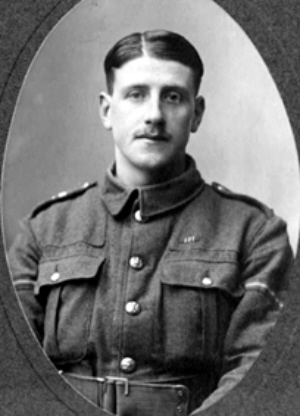
Hugh Noel Conway Davies was the curate of Holy Trinity Church from 1933 to 1936. His role would have been to support the vicar who, at that time, was Rev. George Herbert Marshall DSO.
Hugh, known as Noel, was born in Llanfynydd, Flintshire in December 1892. Noel’s mother, 37 year-old Marie, passed away eighteen months later, just a few weeks after the birth of her sixth child. Noel’s father was Rev William Taliesin Davies, a clergyman from Caernarvon. Subsequently Maria’s cousin, Martha Garlick, moved into The Rectory in Llanfynydd to care for the young, grieving family.
The 1911 census shows that, by the age of 18, Noel was a student at Kelham Hall in Nottingham. Originally this was where the Society of the Sacred Mission prepared students for missionary service. When Noel attended the college they trained clergy for the Church of England. Noel went on to study medicine at Liverpool University.
By September 1st 1915, Noel was serving in France as Private H.N.C. Davies, 3856, 12th Battalion Royal Fusiliers. Noel rose to the rank of Corporal and was next attached to the 29th Battalion, London Regiment. Serving as a doctor’s medical assistant, Noel was in charge of 30 stretcher bearers. These brave men went over the tops of the trenches unarmed, carrying a stretcher and medical supplies.
The Church Family newspaper of Friday 9th March 1917 reported how Noel had been awarded the Military Medal plus Bar. Instituted in March 1916, this medal was awarded to non-commissioned officers (NCOs) and men of the British Army for acts of bravery during World War I. The addition of the bar indicates a further act of bravery.
On one occasion Noel was responsible for saving the life of a sergeant and several other men of his Company who had been buried in their dug out; digging them out whilst under enemy fire. Another time he went out into “No Man’s Land” and attended to the wounded, bringing them in whilst again under fire. Finally, while his Company was under fire in the trenches, a call came in to say some of their men were struggling to keep hold of a vantage point. They had to move or suffer the consequences but to do so meant leaving behind their wounded. Noel asked for volunteers to help him to bring them back and five went with him and brought them away. Three of those who volunteered were wounded and two were killed. Not only was Noel awarded the Military Medal but he was also offered a commission which he refused. One can only imagine the pain he must have felt at the loss of the lives of those men who volunteered on his request.
As far as I can tell, the record of Noel’s military service has not survived. About 60% of service records were damaged or destroyed in September 1940 when the War Office in London was bombed. I have managed to find Noel on the Medal Rolls Index and the Service Medal & Award Rolls. He was awarded the Victory & British Medals and the 1914-15 Star. Worn together, these medals became known as “Pip, Squeak and Wilfred”.
In 1924 Noel married Ruby Williams in Pembroke and by 1932 they had arrived in Yorkshire. Noel was ordained as a deacon at Wakefield Cathedral in May 1932 and in June the following year he was ordained as a priest. In January 1936 he left Ossett having accepted the living at St Peter’s at Hartshead where he stayed for the next 20 years1. Noel had a deep interest in history and recorded the history of St Peter’s Church and its links with the Brontës.
Noel also made recordings of the history of Robin Hood and this was even broadcast in America. It is said by some that Robin Hood cut his last arrows from a yew tree in the churchyard of St Peter’s, the dead trunk of which can still be seen standing there today.
In 1956 Noel left Yorkshire when he became the Vicar of St Katherine’s in Teversal, Nottingham. He died in 1959 and is buried in the churchyard there.
References:
1. The story of Hugh Noel Conway Davies. A cutting from the ‘Church Family’, 09 March 1917